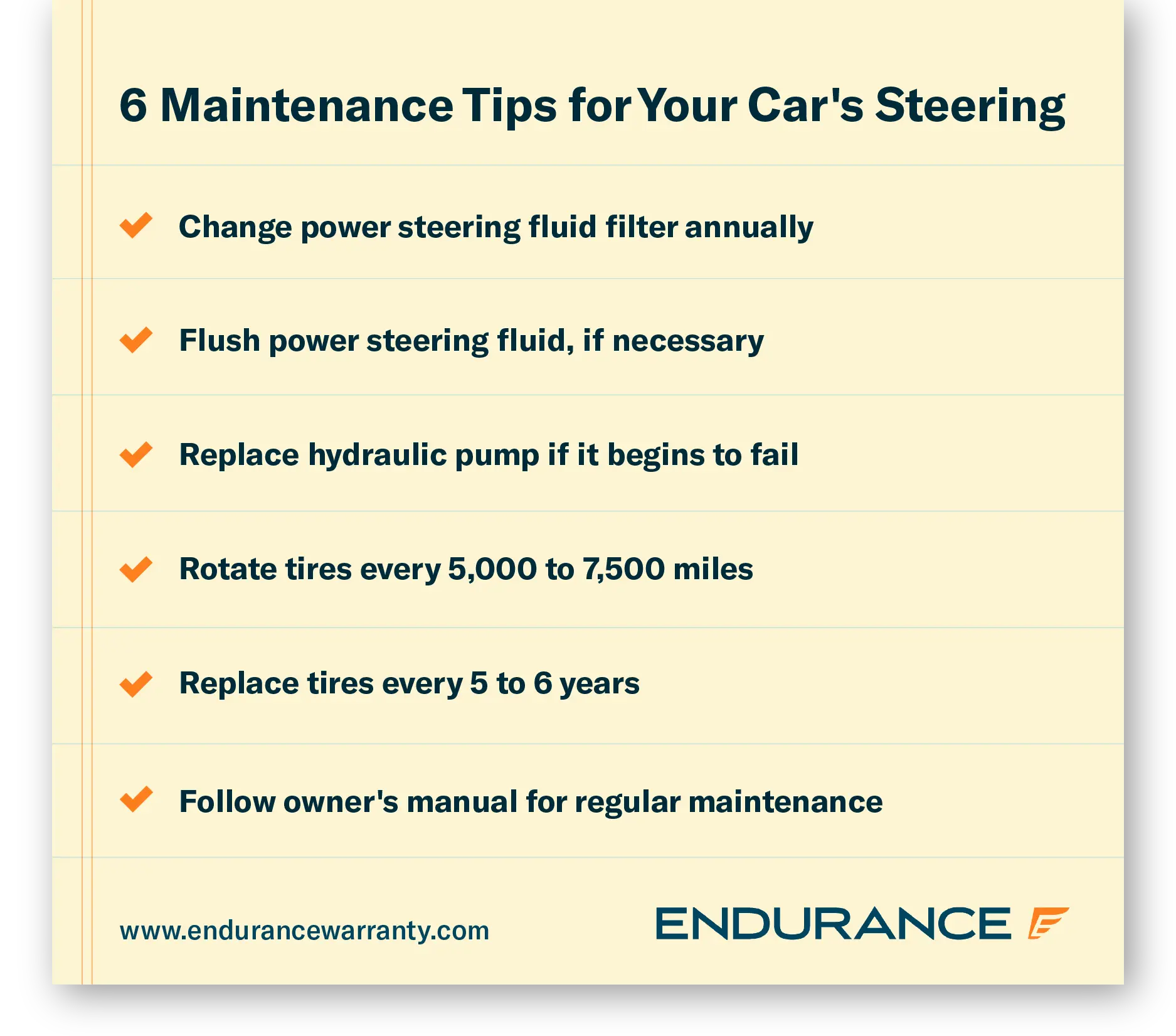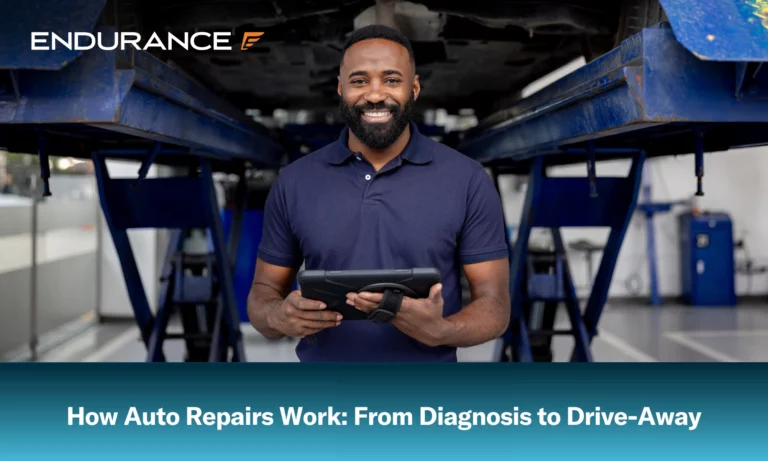The Science Behind Your Car’s Steering System

At some point during the many drives you take throughout your lifetime, you might wonder how the steering system of your vehicle works. After all, winding down a mountain road and feeling the crisp air whipping past you at each bend while your vehicle seemingly sticks to the road can be astounding.
Automobiles are more than just wheels connected to tires. Rather, they’re a symphony of science that turns your gestures at the wheel into movement on the road. Learning about your vehicle’s steering system works can be interesting – and even make you a better driver! In this article, we’ll review the nuances of your steering system, how it works, and the mechanics behind it all.
The Basic Mechanics of Steering
The basics of the steering system on your vehicle start with one fundamental principle: leverage. As you turn the steering wheel on your vehicle, which is essentially a large lever, your movement is amplified. The steering column then activates, which is a sturdy shaft on your vehicle connecting the wheel to the rack and pinion. As you turn the wheel, the steering column uses the pinion gear to rotate at the end, which engages teeth on the rack, essentially a long, bar-shaped gear.
This back-and-forth effort of the rack then pushes something known as the tie rods, which are directly connected to the wheels. These rods move in opposite directions, which allows the wheels on your vehicle to turn accordingly. While it may seem somewhat complicated, it is actually a simple and elegant way of turning your rotational effort into a linear movement that a vehicle needs to steer.
The Different Types of Steering Systems
As mentioned, steering systems on a vehicle work by using the principle of leverage. As vehicles have evolved over the years, however, new types of steering systems have emerged that aim to improve the overall driving process. Manual, power, and adaptive steering are three of the most common types and learning the differences between each can help you understand which your vehicle utilizes.
Manual Steering
Manual steering is the simplest type of steering in a vehicle and is also the oldest of the three. This type of steering relies entirely on the power the driver has and utilizes the rack and pinion mentioned above. It is generally featured on lighter vehicles as there is greater resistance from the vehicle when it weighs more, which can make steering difficult for a driver. In older vehicles, the way to determine whether manual steering was used was to look at if the vehicle was an automatic or stick shift. However, this has changed in recent years as some manual vehicles now have power steering systems.
Power Steering
As cars began to evolve and become heavier, manual steering was becoming a challenge for some drivers. As a result, hydraulic and electric power steering were introduced to make the driving experience easier. Hydraulic power steering works by using a hydraulic pump in the steering system, which supplies pressurized fluid to the steering rack. This fluid then reduces the strength and resistance applied to the rack, thus making the vehicle more responsive at the wheel. The power from the hydraulic pump comes from another part under the hood known as the serpentine belt.
On the other hand, some vehicles have an electric power steering system. Rather than using hydraulic fluid to reduce the burden the driver feels behind the wheel, electrical energy serves as a conduit. Specifically, a bidirectional magnet remains permanently attached to the steering gear or column. A sensor detects movement from the wheel, activating the electric motor. The assistance comes from this motor.
Adaptive and Active Steering
Adaptive steering essentially takes all of the benefits of power steering and amplifies them. Adaptive steering is a technology which monitors in real time how the vehicle is being driven, then optimizes the steering ratio to the vehicle’s speed and power. Adaptive or active steering often has two modes (normal and sport) which engage the driving mechanism to different degrees.
Active steering even goes a step further by using sensors for features such as “lane assist,” which can keep your vehicle from accidentally merging into other lanes.
Technological Advancements in Steering
The modern day has seen many technological advancements impacting vehicles, with more and more advancements occurring on a daily basis. Steer-by-wire systems, as an example, are paving the way for the future by replacing mechanical linkages with electrical signals instead. This means that an incredible level of customization and adaptability within the driving experience can occur.
Going further, artificial intelligence is resulting in improvements in autonomous driving by taking control of the wheel entirely. Companies such as Waymo have demonstrated this by introducing self-driving vehicles in San Francisco and Phoenix, spurred by statistics such as 94% of U.S. traffic crashes are the result of human error and that there are, on average, 1.35 million deaths worldwide due to roadway accidents every year. It’s only a matter of time before this technology is introduced into passenger vehicles.
The Importance of Steering System Maintenance
Given how fast the technology in steering systems is advancing, it has never been more important to handle maintenance on a regular basis. Even small problems can have a compounding effect, resulting in the entire steering system, from the front wheels to the rack and pinion steering system itself having issues. That’s why the following maintenance items should be taken care of on a regular basis:

- Change your power steering fluid filter on an annual basis
- Have your power steering fluid flushed if necessary
- Replace the hydraulic pump if it begins to fail
- Rotate your tires every 5,000 to 7,500 miles
- Replace the tires on your vehicle every five to six years
- Take care of regular maintenance check-ups as outlined by your vehicle manufacturer
Extended Warranties and Steering System Protection
Due to the intricacy of modern car steering systems, fixing issues can come with a heavy price tag that makes you wonder if the maneuverability of your power-assisted steering is actually worth it. Manufacturer warranties often have limited coverage for the steering inputs on your vehicle, which is where an extended warranty can be used to fill in the gap.
Automotive extended warranties, more accurately called vehicle service contracts (VSCs), often offer protection for smaller components such as the power steering pump, the steering shaft, ball bearings, the suspension system, and more. To reduce repair costs resulting from manufacturing errors, consider adding an extended warranty to your vehicle to protect the steering mechanism.
Protecting Your Steering System With Endurance
No one wants to find themselves driving down the road when their steering system stops responding. While recurring steering system maintenance can certainly reduce the risk of this happening, it is not foolproof. All vehicles can have manufacturing issues under the hood, and the steering system is no exception.
An auto protection plan, such as those offered by Endurance, can reduce the repair costs associated with these issues. We offer customizable levels of coverage for the steering system, suspension, and drive axles. In addition, we offer useful standard perks such as 24/7 roadside assistance, towing, rental car reimbursement, and trip interruption coverage.
Every new Endurance customer can take advantage of our Elite Benefits package for a small activation fee. The perks of these benefits include complete tire coverage, key fob replacement, up to $1,000 in total loss protection, and more.
To learn more about how Endurance can protect your vehicle, call (800) 253-8203 to request a FREE quote or shop online to see your price now!
Read more informative articles, such as comparisons of extended warranty providers, car and SUV buying guides, expert auto tips, and more, on the Endurance Warranty blog.













Larry Witherspoon Jr. is a co-founder and Executive Director of the Automotive Training Center. Larry has held multiple leadership positions in the U. S. Navy and with various Fortune 100 companies. In addition to his business experience, Larry grew up understanding the difficulties all young men face becoming adults especially those that come from challenging circumstances. He has taken those experiences growing up and combined them with his passion for vehicles to start the Automotive Training Center. Read more about Larry.